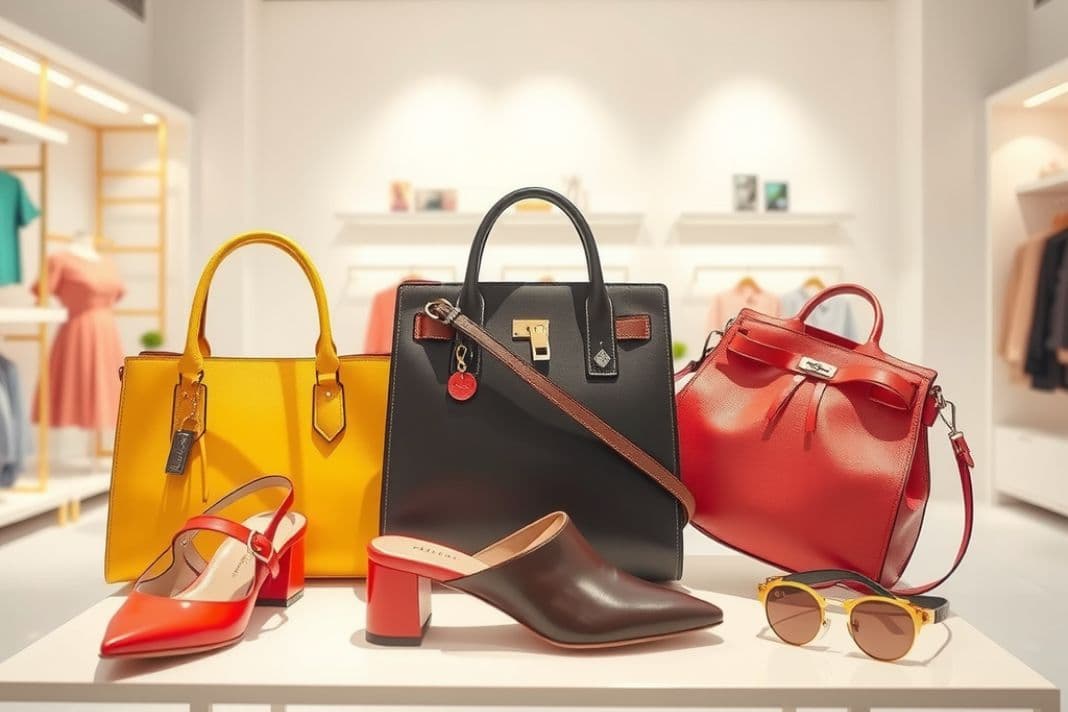In the dynamic realm of retail, capturing customers’ attention and driving sales hinges on a profound grasp of consumer psychology. Among the most effective tools at a retailer’s disposal is the “Rule of Three” – a visual merchandising technique proven to elevate engagement, retention, and revenue.
Drawing from my extensive experience as a trade marketing specialist, I’ve observed the remarkable impact of strategically arranging products in trios on a store’s overall performance.
This in-depth guide will explore the scientific underpinnings of this principle and provide actionable strategies for harnessing its potential in your retail displays.
Decoding the Rule of Three
The human brain is inherently drawn to odd numbers, making three items more visually appealing and memorable. Research in cognitive psychology has revealed that customers allocate 40% more time to displays arranged in groups of three compared to even-numbered configurations.
This inclination towards asymmetry is rooted in how our minds process information – trio setups are more easily comprehended and retained than larger or more intricate arrangements.
Cognitive Load Theory
Cognitive Load Theory sheds light on why showcasing products in threes minimizes mental exertion and optimizes decision-making.
When confronted with an overabundance of choices, shoppers experience decision fatigue, resulting in choice paralysis and abandoned purchases, which can be alleviated by using the rule of three.
By thoughtfully curating displays with just three focal points, retailers can streamline the buying journey and enhance conversion rates.
Gestalt Principles
The Rule of Three aligns seamlessly with Gestalt psychology principles, which delve into how our brains perceive and organize visual information.
By arranging items in a pyramid formation, with a central hero product flanked by two supporting elements, a sense of balance and completion is achieved.
This subconsciously satisfying layout captivates the eye and encourages shoppers to engage with the entire set.
The Magic of Symmetry and Asymmetry
While the Rule of Three capitalizes on the appeal of asymmetry, it’s important to note the role of symmetry in visual merchandising. Symmetrical displays create a sense of order and stability, which can be particularly effective for showcasing luxury or premium products, especially when arranged in sets of three.
However, incorporating asymmetrical elements within a larger symmetrical framework can add visual interest and draw attention to specific items.
Striking a balance between symmetry and asymmetry is key to creating compelling displays that guide the customer’s eye and influence their purchasing decisions.
Benefits of Using the Rule of Three in Merchandising
Implementing the Rule of Three in your visual merchandising strategy offers a plethora of benefits that directly impact your bottom line. Let’s explore some key advantages:
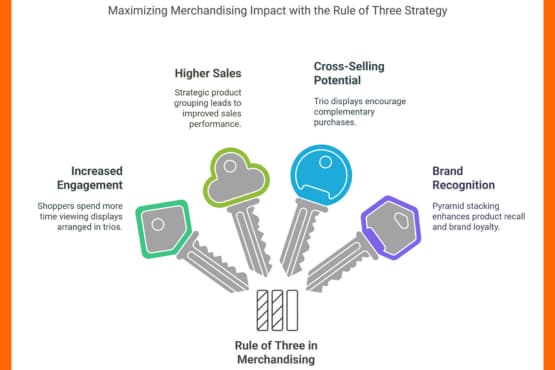
Increased Customer Engagement
Eye-tracking studies have revealed that shoppers spend 15% longer viewing displays arranged in trios compared to other configurations.
This increased engagement translates to higher product awareness, consideration, and ultimately, sales. By capturing and holding customers’ attention, the Rule of Three maximizes the impact of your merchandising efforts.
Higher Sales and Conversion Rates
Brands that have embraced the Rule of Three have seen remarkable improvements in their sales performance. Staghead Designs, a jewelry retailer, experienced a 22% increase in click-through rates after implementing trio-based product displays. This showcases the power of strategic product grouping in driving customer interest and encouraging purchases.
Cross-Selling and Upselling Potential
The Rule of Three creates natural opportunities for cross-selling and upselling. Fashion retailer Princess Polly successfully reduced cart abandonment by 17% by introducing “Complete the Look” trios – curated sets featuring complementary items.
By presenting customers with thoughtfully selected product combinations, you can increase average order value and boost overall revenue.
Enhanced Brand Recognition and Recall
Arranging products in a pyramid formation not only attracts attention but also improves brand recognition and recall. Studies have shown that pyramid stacking enhances product recall by an impressive 65% compared to linear arrangements.
By leveraging the Rule of Three, you create memorable displays that leave a lasting impression on customers, fostering brand loyalty and repeat purchases.
Retail Giants Harnessing the Power of Three
Across various industries, prominent brands have successfully leveraged the Rule of Three to boost sales and foster customer loyalty. Let’s examine a few notable examples:
Apple’s Streamlined Product Lineup
Apple’s triumph in the consumer electronics space can be partially attributed to its curated product offerings. By presenting laptops in three core categories – MacBook Air, MacBook Pro, and MacBook Pro Max – Apple simplifies the decision-making process and encourages customers to compare features within a focused set.
Sephora’s Strategic Fragrance Positioning
Sephora, the beauty retail titan, optimizes sales by arranging fragrances in tiers: budget-friendly, mid-range, and luxury.
This strategic placement taps into the “Goldilocks Effect,” nudging shoppers towards the middle option as the most appealing choice.
By presenting three distinct price points, Sephora caters to a diverse customer base while subtly guiding them towards higher-value purchases, showcasing the benefits of the rule of three.
Fast Food Combo Meal Structure
Fast food giants like McDonald’s and Burger King have long employed the Rule of Three in their combo meal structure.
By offering small, medium, and large options, these restaurants streamline the ordering process and encourage customers to opt for the perceived value of the middle tier.
This time-tested strategy has become a cornerstone in the quick-service industry, driving higher average order values and customer satisfaction.
Implementing the Rule of Three in Your Retail Space
Armed with an understanding of the psychological foundations and real-world applications of the Rule of Three, let’s explore practical strategies for integrating this principle into your visual merchandising plan.
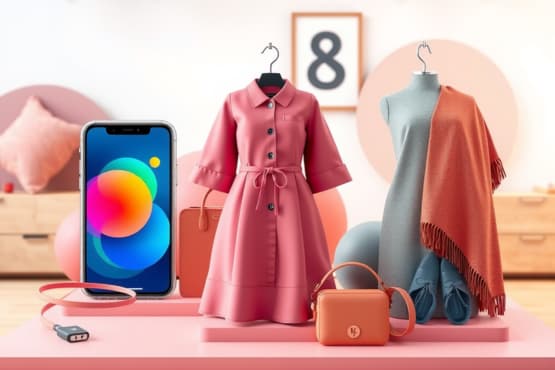
Product Grouping Strategies
- Category Trios: Group complementary products from the same category to encourage cross-selling. For instance, a tech retailer might display a smartphone, a protective case, and a portable charger as a bundled offering.
- Color Coordination: Create visually striking displays by arranging items in monochromatic or gradient color schemes. A fashion retailer could showcase three dresses in shades of blue side-by-side to create an eye-catching and cohesive presentation.
- Purpose-Driven Sets: Utilize sets of three to enhance visual appeal and engagement. Combine products that serve a common purpose or theme. A kitchenware store might feature a knife, cutting board, and cookbook as a curated set for home cooks.
- Seasonal and Thematic Groupings: Consider using three mannequins to create dynamic and engaging seasonal displays. Leverage the power of seasonality and current trends to create relevant and engaging displays using the rule of three in visual merchandising. For example, a home decor store could showcase three coordinating pieces for a cozy fall living room setup, tapping into the seasonal mindset of shoppers.
Pyramid Principle and Focal Points
When arranging your trio displays, utilize the pyramid principle by placing the hero product at the center and slightly elevated.
This positioning draws attention to the focal point and establishes a sense of hierarchy. Employ lighting, signage, and props to further accentuate the central item and guide customers’ eyes through the display.
Optimizing Your Store Layout
To maximize the impact of your Rule of Three displays, strategically position them in high-traffic areas of your store.
Key locations include entrance displays, end caps, and central aisle tables.
For e-commerce retailers, feature curated product trios on homepage banners, category pages, and product detail pages to drive upselling and cross-selling opportunities.
Storytelling in Visual Merchandising
While the Rule of Three provides a structural framework for effective displays, it’s essential to infuse your arrangements with storytelling elements.
Each trio should convey a cohesive narrative that resonates with your target audience. Consider the lifestyle, aspirations, and pain points of your customers when crafting these visual stories.
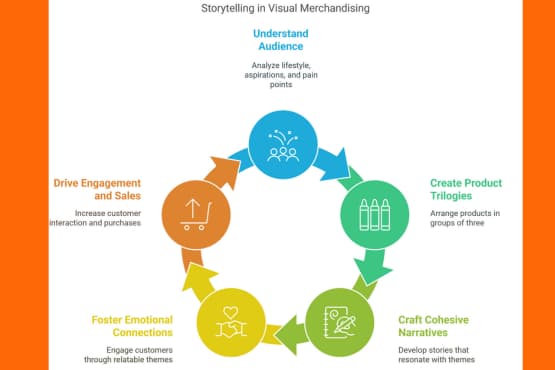
For example, a sports retailer could create a display featuring running shoes, moisture-wicking apparel, and a smartwatch, all tied together by a theme of “Elevate Your Run.”
By presenting products in a context that aligns with customers’ goals and desires, you create an emotional connection that drives engagement and sales.
Common Mistakes (and How to Fix Them)
While the Rule of Three is a powerful merchandising tool, retailers sometimes fall into common pitfalls that hinder its effectiveness. Let’s examine these mistakes and explore solutions to overcome them.
Overcrowding Displays
A common misstep is overcrowding displays with too many products, causing visual clutter and overwhelming customers.
A striking example comes from a cosmetics brand that showcased five lipstick shades in a single display, leading to a 14% increase in customer overwhelm.
To fix this, focus on featuring a hero product trio and reduce visual noise. By streamlining your displays, you create a more appealing and digestible presentation.
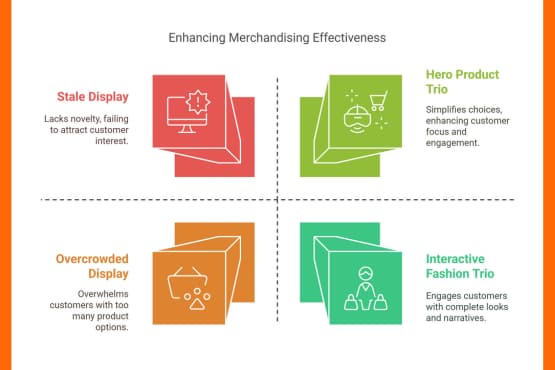
Neglecting Storytelling in Displays
Another pitfall is neglecting the importance of storytelling in visual merchandising. Static mannequins lacking context or narrative fail to engage customers on an emotional level.
In contrast, interactive fashion trios that showcase complete looks and lifestyles evoke desire and encourage purchases.
To rectify this, ensure your displays have a cohesive theme that resonates with your target audience. Use props, signage, and styling to convey a compelling story that draws customers in.
Lack of Regular Updates
Failing to refresh displays regularly leads to stagnation and reduced customer engagement. Stale setups blend into the background and fail to excite shoppers.
The solution? Regularly update your trio displays to align with seasons, trends, and promotional campaigns. By introducing novelty and variety, you keep your store environment dynamic and enticing, encouraging repeat visits and driving sales.
ROI of Visual Merchandising
Implementing the Rule of Three is just the beginning – assessing its impact is vital for refining your visual merchandising strategy over time.
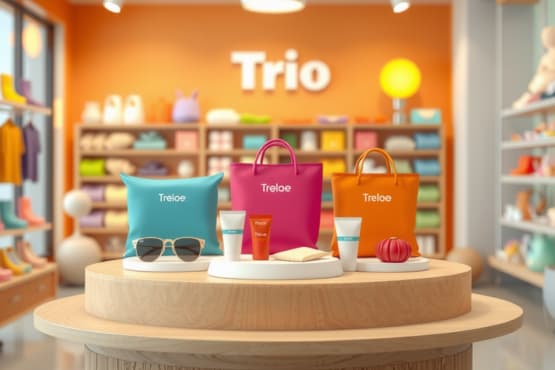
Key performance indicators (KPIs) for gauging the success of your displays include:
- Sales Uplift: Compare the sales performance of products featured in trio displays to their standalone counterparts. A significant uplift indicates that your grouping strategy is resonating with customers.
- Dwell Time: Use in-store analytics tools like heat mapping cameras to track how long customers spend engaging with your displays. Longer dwell times suggest that your arrangements are effectively capturing attention and sparking interest.
- Conversion Rates: Monitor the percentage of shoppers who purchase items from your trio displays. Higher conversion rates signal that your product groupings are successfully guiding customers through the buying journey.
- Customer Feedback: Solicit feedback from customers through surveys or interviews to gain insights into their perceptions of your visual merchandising, especially regarding the effectiveness of three items displayed together. Positive feedback and suggestions for improvement can help you refine your strategies and better meet customer expectations.
The Future of Visual Merchandising: AI and Beyond
As technology continues to reshape the retail landscape, AI-driven merchandising solutions are poised to revolutionize the way brands optimize their product displays.
Algorithmic planogram generators can analyze sales data, customer behavior, and inventory levels to recommend the most effective product groupings and placement strategies.
By combining the power of AI with the psychological principles of the Rule of Three, retailers can create truly data-driven, customer-centric experiences that drive sales and loyalty.
Moreover, the rise of augmented reality (AR) and virtual reality (VR) technologies presents exciting opportunities for visual merchandising.
Retailers can leverage AR to allow customers to visualize how products would look in their homes or on their bodies, enhancing the shopping experience and boosting confidence in purchase decisions.
VR, on the other hand, can be used to create immersive virtual store environments where customers can explore and interact with products in innovative ways.
Conclusion
The rule of three stands as a testament to the enduring power of simplicity in retail, highlighting the benefits of the rule. By tapping into the human brain’s natural affinity for odd numbers and curated choices, brands can create visual merchandising experiences that engage, delight, and convert.
As you embark on your own journey to master this principle, remember that success lies in continuous experimentation, iteration, and analysis, particularly when applying the benefits of the rule of three. Stay attuned to your customers’ evolving needs and preferences, and let data be your guide as you refine your trio strategies over time.
By embracing the power of three and staying at the forefront of visual merchandising trends, you’ll be well-positioned to thrive in the ever-evolving retail landscape. Happy merchandising!

